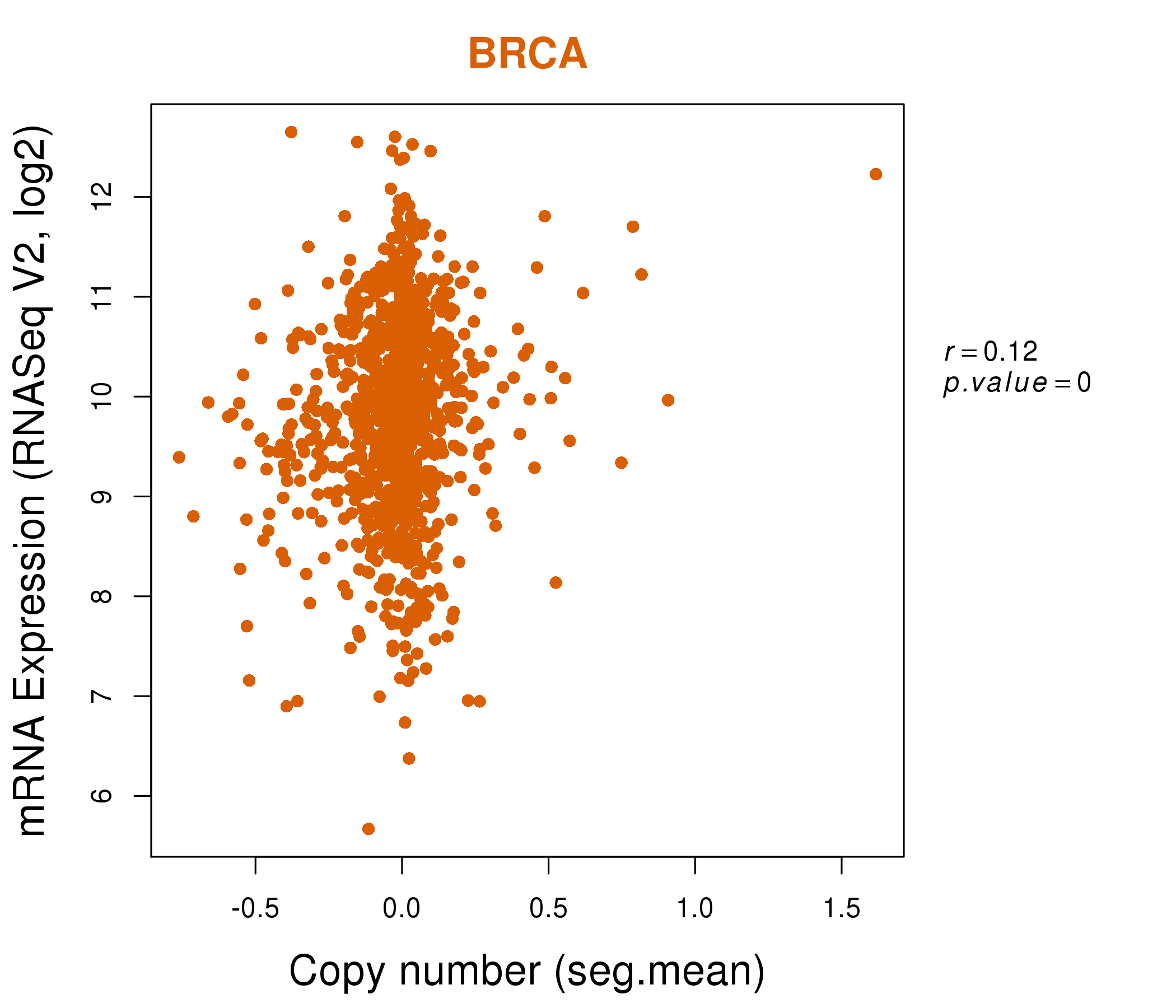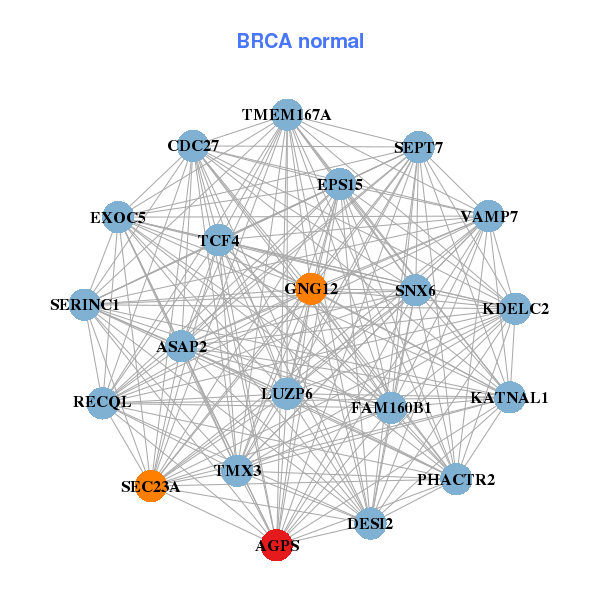|
||||||||||||||||||||||||||||||||||||||||||||||||||||||||||||||||||||||||||||||||||||||||||||||||||||||||||||||||||||||||||||||||||||||||||||||||||||||||||||||||||||||||||||||||||||||||||||||||||||||||||||||||||||||||||||||||||||||||||||||||||||||||||||||||||||||||||||||||||||||||||||||||||||||||||||||||||||||||||
| |
| Phenotypic Information (metabolism pathway, cancer, disease, phenome) |
| |
| |
| Gene-Gene Network Information: Co-Expression Network, Interacting Genes & KEGG |
| |
|
| Gene Summary for AGPS |
| Basic gene info. | Gene symbol | AGPS |
| Gene name | alkylglycerone phosphate synthase | |
| Synonyms | ADAP-S|ADAS|ADHAPS|ADPS|ALDHPSY | |
| Cytomap | UCSC genome browser: 2q31.2 | |
| Genomic location | chr2 :178257470-178408564 | |
| Type of gene | protein-coding | |
| RefGenes | NM_003659.3, | |
| Ensembl id | ENSG00000018510 | |
| Description | aging-associated gene 5 proteinaging-associated protein 5alkyl-DHAP synthasealkyldihydroxyacetonephosphate synthase, peroxisomalalkylglycerone-phosphate synthase | |
| Modification date | 20141207 | |
| dbXrefs | MIM : 603051 | |
| HGNC : HGNC | ||
| Ensembl : ENSG00000018510 | ||
| HPRD : 04337 | ||
| Vega : OTTHUMG00000132530 | ||
| Protein | UniProt: go to UniProt's Cross Reference DB Table | |
| Expression | CleanEX: HS_AGPS | |
| BioGPS: 8540 | ||
| Gene Expression Atlas: ENSG00000018510 | ||
| The Human Protein Atlas: ENSG00000018510 | ||
| Pathway | NCI Pathway Interaction Database: AGPS | |
| KEGG: AGPS | ||
| REACTOME: AGPS | ||
| ConsensusPathDB | ||
| Pathway Commons: AGPS | ||
| Metabolism | MetaCyc: AGPS | |
| HUMANCyc: AGPS | ||
| Regulation | Ensembl's Regulation: ENSG00000018510 | |
| miRBase: chr2 :178,257,470-178,408,564 | ||
| TargetScan: NM_003659 | ||
| cisRED: ENSG00000018510 | ||
| Context | iHOP: AGPS | |
| cancer metabolism search in PubMed: AGPS | ||
| UCL Cancer Institute: AGPS | ||
| Assigned class in ccmGDB | C | |
| Top |
| Phenotypic Information for AGPS(metabolism pathway, cancer, disease, phenome) |
| Cancer | CGAP: AGPS |
| Familial Cancer Database: AGPS | |
| * This gene is included in those cancer gene databases. |
|
|
|
|
|
|
| ||||||||||||||||||||||||||||||||||||||||||||||||||||||||||||||||||||||||||||||||||||||||||||||||||||||||||||||||||||||||||||||||||||||||||||||||||||||||||||||||||||||||||||||||||||||||||||||||||||||||||||||||||||||||||||||||||||||||||||||||||||||||||||||||||||||||||||||||||||||||||||||||||||||||||||||||||||
Oncogene 1 | Significant driver gene in | |||||||||||||||||||||||||||||||||||||||||||||||||||||||||||||||||||||||||||||||||||||||||||||||||||||||||||||||||||||||||||||||||||||||||||||||||||||||||||||||||||||||||||||||||||||||||||||||||||||||||||||||||||||||||||||||||||||||||||||||||||||||||||||||||||||||||||||||||||||||||||||||||||||||||||||||||||||||||
| cf) number; DB name 1 Oncogene; http://nar.oxfordjournals.org/content/35/suppl_1/D721.long, 2 Tumor Suppressor gene; https://bioinfo.uth.edu/TSGene/, 3 Cancer Gene Census; http://www.nature.com/nrc/journal/v4/n3/abs/nrc1299.html, 4 CancerGenes; http://nar.oxfordjournals.org/content/35/suppl_1/D721.long, 5 Network of Cancer Gene; http://ncg.kcl.ac.uk/index.php, 1Therapeutic Vulnerabilities in Cancer; http://cbio.mskcc.org/cancergenomics/statius/ |
| REACTOME_PEROXISOMAL_LIPID_METABOLISM REACTOME_METABOLISM_OF_LIPIDS_AND_LIPOPROTEINS | |
| OMIM | |
| Orphanet | |
| Disease | KEGG Disease: AGPS |
| MedGen: AGPS (Human Medical Genetics with Condition) | |
| ClinVar: AGPS | |
| Phenotype | MGI: AGPS (International Mouse Phenotyping Consortium) |
| PhenomicDB: AGPS | |
| Mutations for AGPS |
| * Under tables are showing count per each tissue to give us broad intuition about tissue specific mutation patterns.You can go to the detailed page for each mutation database's web site. |
| - Statistics for Tissue and Mutation type | Top |
 |
| - For Inter-chromosomal Variations |
| * Inter-chromosomal variantions includes 'interchromosomal amplicon to amplicon', 'interchromosomal amplicon to non-amplified dna', 'interchromosomal insertion', 'Interchromosomal unknown type'. |
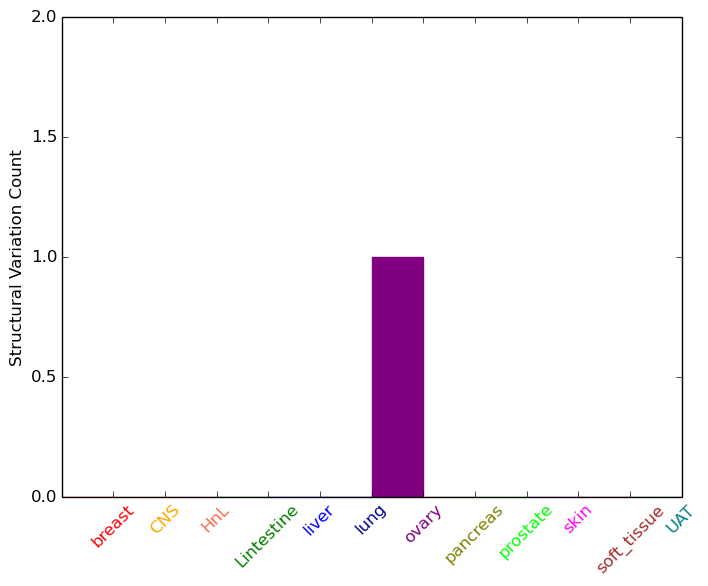 |
| - For Intra-chromosomal Variations |
| There's no intra-chromosomal structural variation. |
| Sample | Symbol_a | Chr_a | Start_a | End_a | Symbol_b | Chr_b | Start_b | End_b |
| cf) Tissue number; Tissue name (1;Breast, 2;Central_nervous_system, 3;Haematopoietic_and_lymphoid_tissue, 4;Large_intestine, 5;Liver, 6;Lung, 7;Ovary, 8;Pancreas, 9;Prostate, 10;Skin, 11;Soft_tissue, 12;Upper_aerodigestive_tract) |
| * From mRNA Sanger sequences, Chitars2.0 arranged chimeric transcripts. This table shows AGPS related fusion information. |
| ID | Head Gene | Tail Gene | Accession | Gene_a | qStart_a | qEnd_a | Chromosome_a | tStart_a | tEnd_a | Gene_a | qStart_a | qEnd_a | Chromosome_a | tStart_a | tEnd_a |
| DB074890 | RMI2 | 1 | 353 | 16 | 11374744 | 11375187 | AGPS | 354 | 554 | 2 | 178257504 | 178257704 | |
| BC008192 | HEATR2 | 17 | 919 | 7 | 810105 | 825405 | AGPS | 919 | 1443 | 2 | 178408042 | 178408566 | |
| AW889598 | HNRNPAB | 8 | 136 | 5 | 177637986 | 177638114 | AGPS | 118 | 235 | 2 | 178328933 | 178329049 | |
| Top |
| Mutation type/ Tissue ID | brca | cns | cerv | endome | haematopo | kidn | Lintest | liver | lung | ns | ovary | pancre | prost | skin | stoma | thyro | urina | |||
| Total # sample | 1 | 1 | 8 | |||||||||||||||||
| GAIN (# sample) | 1 | 1 | 8 | |||||||||||||||||
| LOSS (# sample) | 1 |
| cf) Tissue ID; Tissue type (1; Breast, 2; Central_nervous_system, 3; Cervix, 4; Endometrium, 5; Haematopoietic_and_lymphoid_tissue, 6; Kidney, 7; Large_intestine, 8; Liver, 9; Lung, 10; NS, 11; Ovary, 12; Pancreas, 13; Prostate, 14; Skin, 15; Stomach, 16; Thyroid, 17; Urinary_tract) |
| Top |
|
 |
| Top |
| Stat. for Non-Synonymous SNVs (# total SNVs=42) | (# total SNVs=17) |
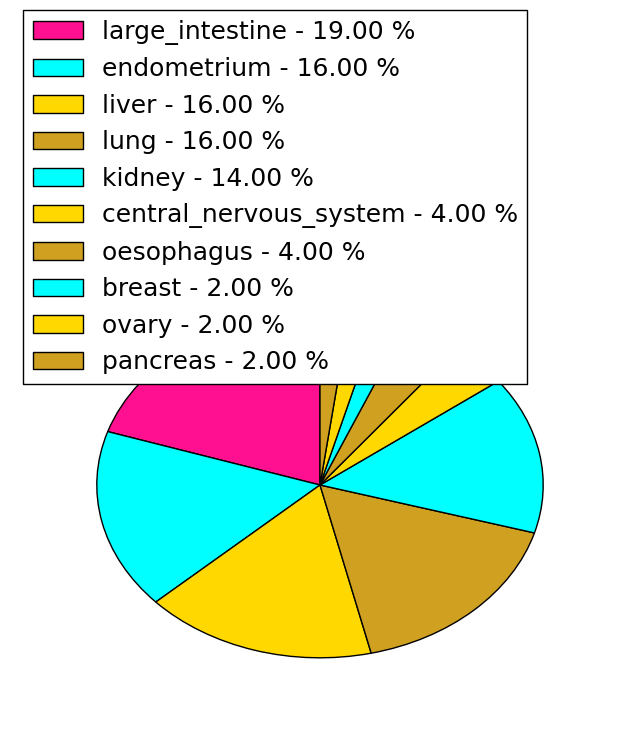 | 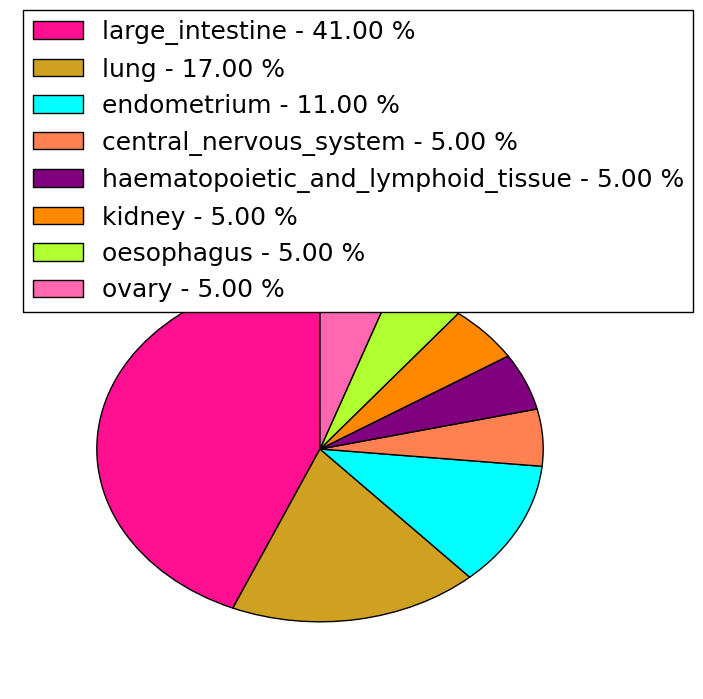 |
(# total SNVs=1) | (# total SNVs=1) |
 | 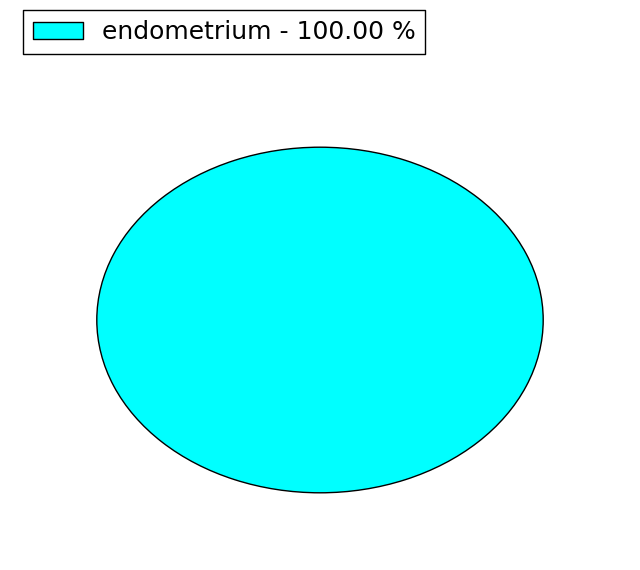 |
| Top |
| * When you move the cursor on each content, you can see more deailed mutation information on the Tooltip. Those are primary_site,primary_histology,mutation(aa),pubmedID. |
| GRCh37 position | Mutation(aa) | Unique sampleID count |
| chr2:178310273-178310273 | p.? | 2 |
| chr2:178285070-178285070 | p.E112K | 2 |
| chr2:178299132-178299132 | p.K143T | 2 |
| chr2:178301756-178301756 | p.R204Q | 2 |
| chr2:178378584-178378584 | p.T549P | 2 |
| chr2:178378585-178378585 | p.T549I | 2 |
| chr2:178402821-178402821 | p.Q625Q | 2 |
| chr2:178364459-178364459 | p.? | 2 |
| chr2:178378622-178378622 | p.P561P | 1 |
| chr2:178257705-178257705 | p.A63V | 1 |
| Top |
|
 |
| Point Mutation/ Tissue ID | 1 | 2 | 3 | 4 | 5 | 6 | 7 | 8 | 9 | 10 | 11 | 12 | 13 | 14 | 15 | 16 | 17 | 18 | 19 | 20 |
| # sample | 4 | 1 | 9 | 3 | 1 | 2 | 7 | 2 | 1 | 3 | 3 | 1 | 7 | |||||||
| # mutation | 4 | 1 | 9 | 3 | 1 | 2 | 9 | 2 | 1 | 3 | 3 | 1 | 8 | |||||||
| nonsynonymous SNV | 3 | 1 | 4 | 3 | 1 | 2 | 4 | 1 | 3 | 2 | 6 | |||||||||
| synonymous SNV | 1 | 5 | 5 | 1 | 1 | 1 | 1 | 2 |
| cf) Tissue ID; Tissue type (1; BLCA[Bladder Urothelial Carcinoma], 2; BRCA[Breast invasive carcinoma], 3; CESC[Cervical squamous cell carcinoma and endocervical adenocarcinoma], 4; COAD[Colon adenocarcinoma], 5; GBM[Glioblastoma multiforme], 6; Glioma Low Grade, 7; HNSC[Head and Neck squamous cell carcinoma], 8; KICH[Kidney Chromophobe], 9; KIRC[Kidney renal clear cell carcinoma], 10; KIRP[Kidney renal papillary cell carcinoma], 11; LAML[Acute Myeloid Leukemia], 12; LUAD[Lung adenocarcinoma], 13; LUSC[Lung squamous cell carcinoma], 14; OV[Ovarian serous cystadenocarcinoma ], 15; PAAD[Pancreatic adenocarcinoma], 16; PRAD[Prostate adenocarcinoma], 17; SKCM[Skin Cutaneous Melanoma], 18:STAD[Stomach adenocarcinoma], 19:THCA[Thyroid carcinoma], 20:UCEC[Uterine Corpus Endometrial Carcinoma]) |
| Top |
| * We represented just top 10 SNVs. When you move the cursor on each content, you can see more deailed mutation information on the Tooltip. Those are primary_site, primary_histology, mutation(aa), pubmedID. |
| Genomic Position | Mutation(aa) | Unique sampleID count |
| chr2:178386078 | p.T593T | 2 |
| chr2:178301756 | p.Q625Q | 2 |
| chr2:178402821 | p.R204Q | 2 |
| chr2:178301497 | p.D154N | 1 |
| chr2:178386040 | p.T370I | 1 |
| chr2:178402894 | p.V594I | 1 |
| chr2:178310322 | p.S174L | 1 |
| chr2:178357901 | p.I381M | 1 |
| chr2:178301498 | p.A602S | 1 |
| chr2:178386063 | p.M201I | 1 |
| * Copy number data were extracted from TCGA using R package TCGA-Assembler. The URLs of all public data files on TCGA DCC data server were gathered on Jan-05-2015. Function ProcessCNAData in TCGA-Assembler package was used to obtain gene-level copy number value which is calculated as the average copy number of the genomic region of a gene. |
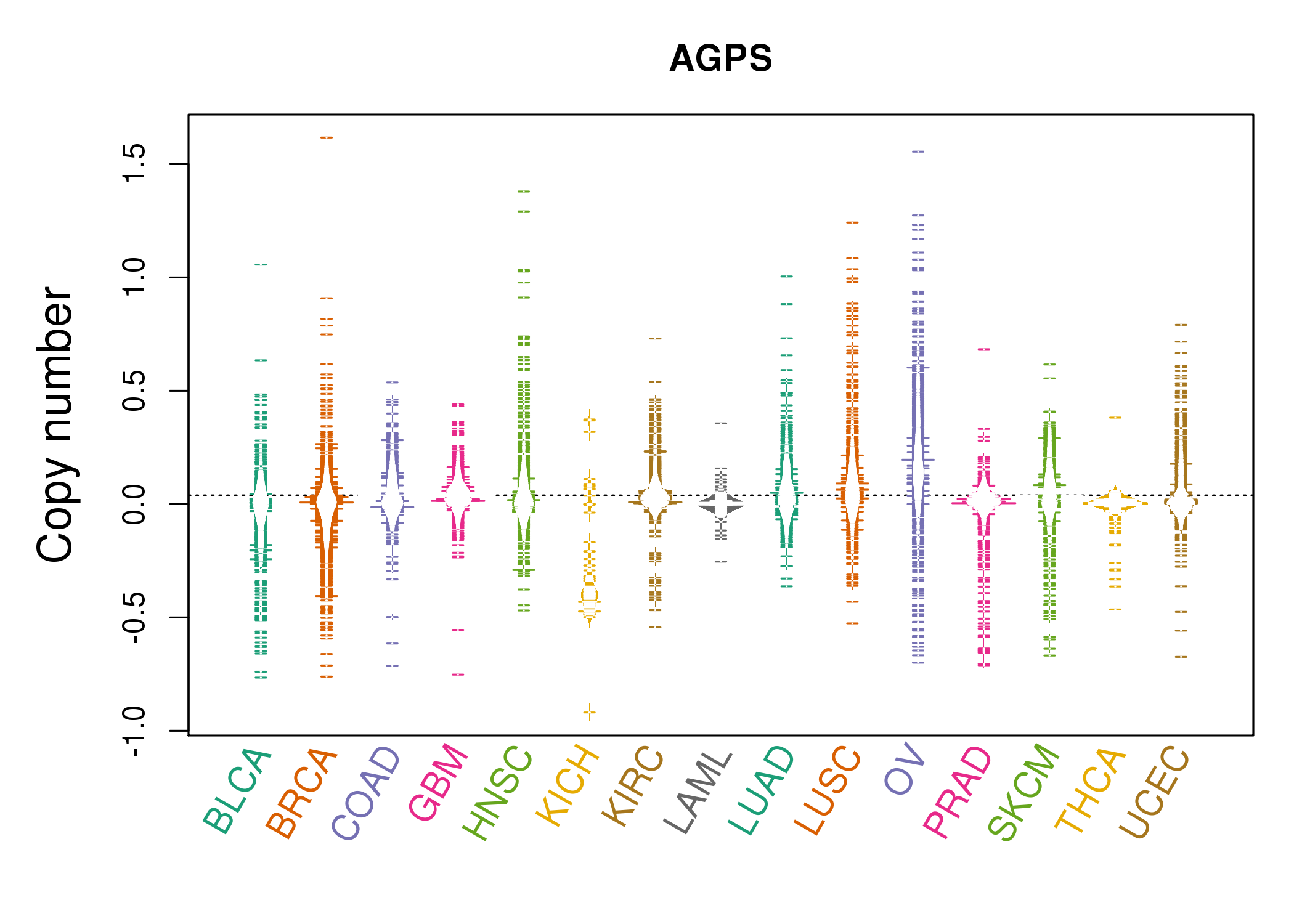 |
| cf) Tissue ID[Tissue type]: BLCA[Bladder Urothelial Carcinoma], BRCA[Breast invasive carcinoma], CESC[Cervical squamous cell carcinoma and endocervical adenocarcinoma], COAD[Colon adenocarcinoma], GBM[Glioblastoma multiforme], Glioma Low Grade, HNSC[Head and Neck squamous cell carcinoma], KICH[Kidney Chromophobe], KIRC[Kidney renal clear cell carcinoma], KIRP[Kidney renal papillary cell carcinoma], LAML[Acute Myeloid Leukemia], LUAD[Lung adenocarcinoma], LUSC[Lung squamous cell carcinoma], OV[Ovarian serous cystadenocarcinoma ], PAAD[Pancreatic adenocarcinoma], PRAD[Prostate adenocarcinoma], SKCM[Skin Cutaneous Melanoma], STAD[Stomach adenocarcinoma], THCA[Thyroid carcinoma], UCEC[Uterine Corpus Endometrial Carcinoma] |
| Top |
| Gene Expression for AGPS |
| * CCLE gene expression data were extracted from CCLE_Expression_Entrez_2012-10-18.res: Gene-centric RMA-normalized mRNA expression data. |
 |
| * Normalized gene expression data of RNASeqV2 was extracted from TCGA using R package TCGA-Assembler. The URLs of all public data files on TCGA DCC data server were gathered at Jan-05-2015. Only eight cancer types have enough normal control samples for differential expression analysis. (t test, adjusted p<0.05 (using Benjamini-Hochberg FDR)) |
 |
| Top |
| * This plots show the correlation between CNV and gene expression. |
: Open all plots for all cancer types
 |
|
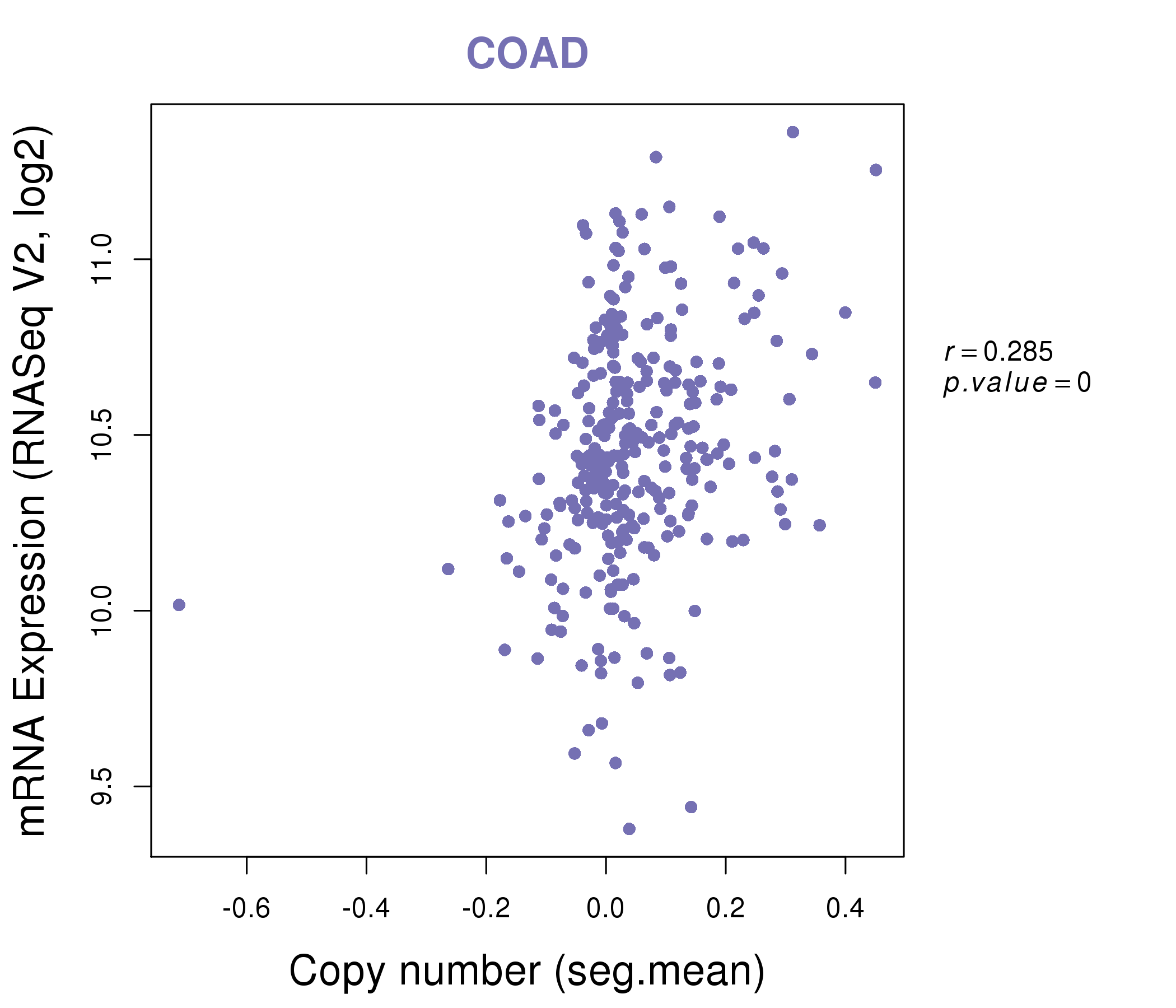 |
|
| Top |
| Gene-Gene Network Information |
| * Co-Expression network figures were drawn using R package igraph. Only the top 20 genes with the highest correlations were shown. Red circle: input gene, orange circle: cell metabolism gene, sky circle: other gene |
: Open all plots for all cancer types
 |
|
| AGPS,DNAH7,DNAL1,EDEM3,FAM73A,GCC2,IBTK, KIF27,KLF3,LOC100130691,NEK4,NFE2L2,PJA2,POLK, TMF1,TRIP11,TTC30A,TTC30B,UBR3,USP33,ZNF484 | AGPS,ASAP2,CDC27,EPS15,EXOC5,FAM160B1,GNG12, KATNAL1,KDELC2,LUZP6,PHACTR2,DESI2,RECQL,SEC23A, SEPT7,SERINC1,SNX6,TCF4,TMEM167A,TMX3,VAMP7 |
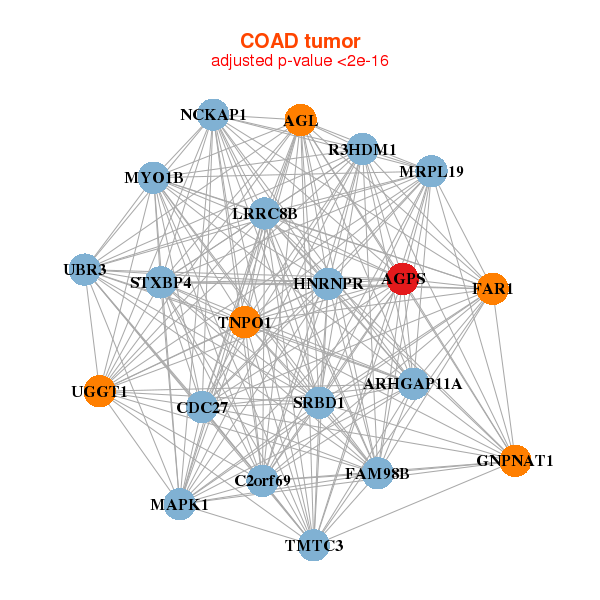 |
|
| AGL,AGPS,ARHGAP11A,C2orf69,CDC27,FAM98B,FAR1, GNPNAT1,HNRNPR,LRRC8B,MAPK1,MRPL19,MYO1B,NCKAP1, R3HDM1,SRBD1,STXBP4,TMTC3,TNPO1,UBR3,UGGT1 | AGPS,CAPRIN1,CDC25A,DARS2,DLAT,ECT2,FBXO45, G3BP1,HDAC2,HSPA9,HSPD1,LARP4,LARS2,MRPL19, NAA50,NARS,PRPF40A,SERBP1,SRSF1,SRPK1,STT3B |
| * Co-Expression network figures were drawn using R package igraph. Only the top 20 genes with the highest correlations were shown. Red circle: input gene, orange circle: cell metabolism gene, sky circle: other gene |
: Open all plots for all cancer types
| Top |
: Open all interacting genes' information including KEGG pathway for all interacting genes from DAVID
| Top |
| Pharmacological Information for AGPS |
| There's no related Drug. |
| Top |
| Cross referenced IDs for AGPS |
| * We obtained these cross-references from Uniprot database. It covers 150 different DBs, 18 categories. http://www.uniprot.org/help/cross_references_section |
: Open all cross reference information
|
Copyright © 2016-Present - The Univsersity of Texas Health Science Center at Houston @ |






